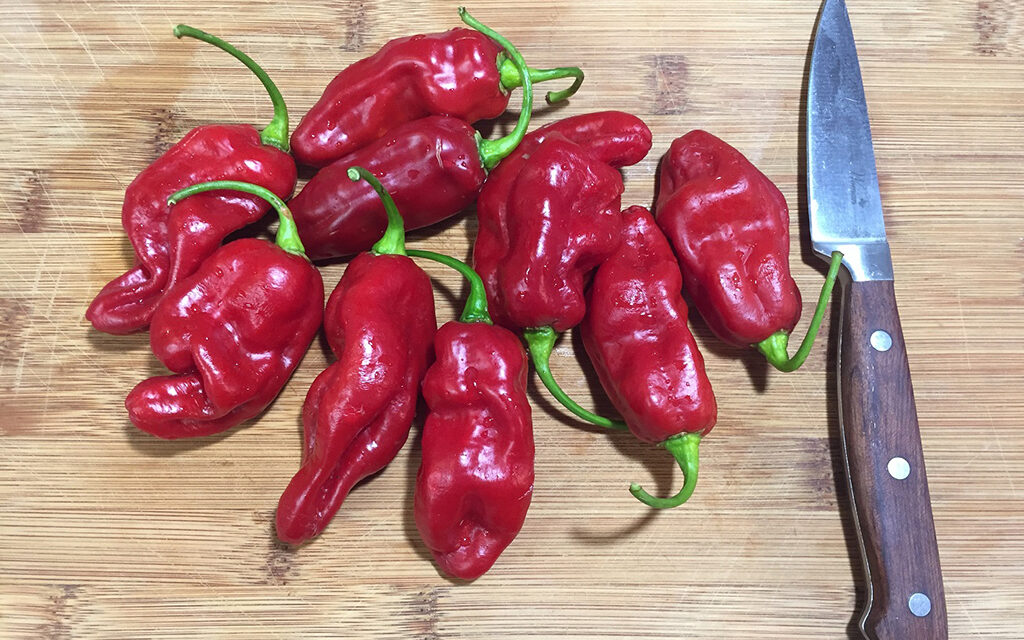by Melinda Myers
Don’t worry if the rest of your family does not appreciate the spicy heat your favorite hot peppers add to entrees, beverages and desserts. Proper pepper selection, care and preparation can help you turn down the heat as needed.
Hot peppers’ spicy heat is measured in Scoville Heat Units named for Wilbur Scoville. The level of heat was originally determined by a panel of individual tasters. Chili peppers were ground and added to a sugar-water solution. The solution was continually diluted until the panelist found the solution no longer burned their mouth. Each pepper was assigned a number based on the amount of sugar-water solution needed to reach that point. Today a more accurate less subjective high–performance liquid chromatography method can be used for measuring the pungency of hot peppers.
Poblano and Siracha rate between 1,000 to 2,500, jalapenos up to 8,000, cayenne can peak at 50,000, habaneros up to 350,000 and one of the hottest, the ghost pepper, at as much as 2,200,000 units. If you like the citrusy flavor of habaneros but not the heat, try the All-America Selections winner Roulette.
Ornamental peppers are edible as well as pretty. Most rate anywhere from 10,000 to 50,000 Scoville units. Chilly Chili ornamental pepper produces an abundance of attractive yellow, orange and red upright fruit on 10 to 12” plants. As the name suggests, they have almost no heat. Mix with flowers for decorative displays in containers and garden beds.
Peppers grow and produce best when day temperatures are 70° to 80° F and night temperatures are 60° to 70° F. Cold, heat and drought are the most common cause of blossom drop, misshapen fruit, and a poor harvest.
Use a hand pruner or garden snips to harvest peppers without damaging the plants. Harvest most hot peppers when fully mature and red for the strongest flavor. Green chili and jalapeno peppers are harvested when green. And some like jalapeno, habanero and Anaheim, are hot whether harvested when green or red. When your summer is filled with long hot days hot peppers tend to be even hotter.
Avoid hot surprises when cooking by labeling hot peppers when growing, harvesting and storing them. Many sweet and hot pepper varieties look similar and confusing the two could be unpleasant. Just keep a glass of milk handy in case you need to neutralize the sting.
Turn down the heat, if needed or desired, when preparing your favorite recipes. Since most of the capsaicin, which gives hot peppers their heat, is in the white membrane that houses the seeds, just remove this and the seeds if you want the flavor with less heat.
Wear rubber gloves and avoid touching your face and eyes when working with hot peppers as they can burn. Wash your hands, utensils and cutting boards when finished.
Turn a portion of your pepper harvest into pickled peppers for the hot pickle fans in the family to enjoy throughout the winter. The key to success and safety is using a tested recipe that contains the right amount of ingredients and processing it properly. Check University or other vetted sources for safe recipes and processing guidelines.
Try some of these strategies and mention the many health benefits to encourage reluctant eaters to try hot peppers. Although hot peppers and spicy food can add to the pain and irritation of ulcers, they do not cause them contrary to some of the hot pepper myths. They do, however, provide gastric relief, kill cancer cells, prevent sinus infection, reduce inflammation, and even burn fat. Over time you may be able to turn up the heat on your favorite recipes for all to enjoy.
Melinda Myers has written more than 20 gardening books, including the recently released Midwest Gardener’s Handbook, 2nd Edition and Small Space Gardening. She hosts The Great Courses “How to Grow Anything” instant video and DVD series and the nationally syndicated Melinda’s Garden Moment TV & radio program. Myers is a columnist and contributing editor for Birds & Blooms magazine and her website is www.MelindaMyers.com.




